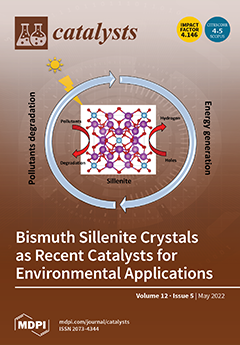The Ni/P ratio of nickel phosphide has an important effect on the catalytic performance toward the deoxygenation of fatty acids to biofuel. The Ni
12P
5 cluster is preferred to model Ni
12P
5 catalyst with butyric acid as the reactant
[...] Read more.
The Ni/P ratio of nickel phosphide has an important effect on the catalytic performance toward the deoxygenation of fatty acids to biofuel. The Ni
12P
5 cluster is preferred to model Ni
12P
5 catalyst with butyric acid as the reactant model of palmitic acid. The catalytic deoxygenation mechanism of butyric acid over Ni
12P
5 cluster has been theoretically investigated at GGA-PBE/DSPP, DNP level in dodecane solution. From butyric acid, the hydrodehydration is predominated to form
n-butanal. Then, from
n-butanal, low temperature benefits the hydroreduction to form butanol and then hydrodehydration to produce
n-butane, whereas high temperature favors the direct decarbonylation to yield propane.
n-Butane originates from
n-butanol through hydrodehydration and not from
n-butylene. Propane comes from
n-butanal through decarbonylation and not from propanol and/or propylene. Additionally, CO stems from
n-butanal through decarbonylation, whereas CO
2 is ruled out from butyric acid through decarboxylation. Compared with Ni
12P
6 cluster, Ni
12P
5 cluster exhibits higher catalytic activity for the formation of butanal,
n-butanol, and
n-butane, while it displays lower catalytic activity toward the direct decarbonylation and dehydration to yield propylene. These results can be attributed to less negative charges of Ni-sites over Ni
12P
5 cluster, compared with Ni
12P
6 cluster.
Full article





